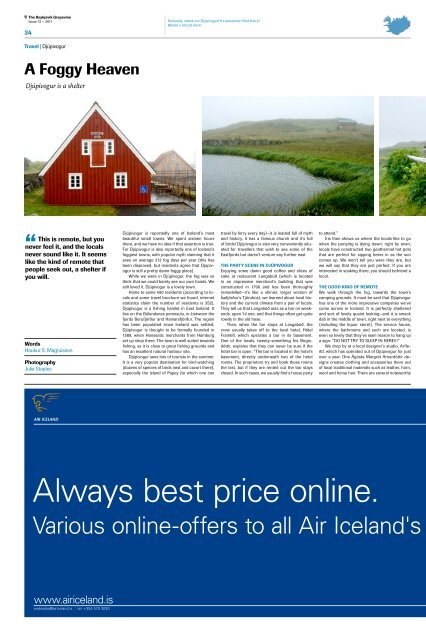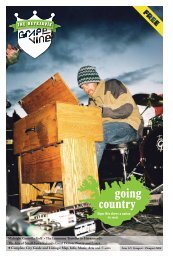Read PDF Online - The Reykjavik Grapevine
Read PDF Online - The Reykjavik Grapevine
Read PDF Online - The Reykjavik Grapevine
Create successful ePaper yourself
Turn your PDF publications into a flip-book with our unique Google optimized e-Paper software.
<strong>The</strong> Reykjavík <strong>Grapevine</strong><br />
Issue 13 — 2011<br />
34<br />
Travel | Djúpivogur<br />
A Foggy Heaven<br />
Djúpivogur is a shelter<br />
“<br />
This is remote, but you<br />
never feel it, and the locals<br />
never sound like it. It seems<br />
like the kind of remote that<br />
people seek out, a shelter if<br />
you will.<br />
Words<br />
Haukur S. Magnússon<br />
Photography<br />
Julia Staples<br />
Always best price online.<br />
Various online-offers to all Air Iceland's<br />
www.airiceland.is<br />
websales@airiceland.is / tel. +354 570 3030<br />
Seriously, check out Djúpivogur! It's awesome! And hurry!<br />
Winter's almost here!<br />
Djúpivogur is reportedly one of Iceland’s most<br />
beautiful small towns. We spent sixteen hours<br />
there, and we have no idea if that assertion is true.<br />
For Djúpivogur is also reportedly one of Iceland’s<br />
foggiest towns, with popular myth claiming that it<br />
sees on average 212 fog days per year (this has<br />
been disproved, but residents agree that Djúpivogur<br />
is still a pretty damn foggy place).<br />
While we were in Djúpivogur, the fog was so<br />
thick that we could barely see our own hands. We<br />
still loved it. Djúpivogur is a lovely town.<br />
Home to some 450 residents (according to locals<br />
and some travel brochure we found, internet<br />
statistics claim the number of residents is 352),<br />
Djúpivogur is a fishing hamlet in East Iceland. It<br />
lies on the Búlandsnes peninsula, in-between the<br />
fjords Berufjörður and Hamarsfjörður. <strong>The</strong> region<br />
has been populated since Iceland was settled;<br />
Djúpivogur is thought to be formally founded in<br />
1589, when Hanseatic merchants from Hamburg<br />
set up shop there. <strong>The</strong> town is well suited towards<br />
fishing, as it is close to great fishing grounds and<br />
has an excellent natural harbour site.<br />
Djúpivogur sees lots of tourists in the summer.<br />
It is a very popular destination for bird-watching<br />
(dozens of species of birds nest and cavort there),<br />
especially the island of Papey (to which one can<br />
travel by ferry every day)—it is loaded full of myth<br />
and history, it has a famous church and it’s full<br />
of birds! Djúpivogur is also very conveniently situated<br />
for travellers that wish to see some of the<br />
Eastfjords but daren’t venture any further east.<br />
THE PARTY SCENE IN DJÚPIVOGUR<br />
Enjoying some damn good coffee and slices of<br />
cake at restaurant Langabúð (which is located<br />
in an impressive merchant’s building that was<br />
constructed in 1790 and has been thoroughly<br />
remodelled—it’s like a shinier, larger version of<br />
Ísafjörður’s Tjöruhús), we learned about local history<br />
and the current climate from a pair of locals.<br />
<strong>The</strong>y tell us that Langabúð acts as a bar on weekends,<br />
open ‘til one, and that things often get quite<br />
rowdy in the old hose.<br />
<strong>The</strong>n, when the fun stops at Langabúð, the<br />
crew usually takes off to the local hotel, Hótel<br />
Framtíð, which operates a bar in its basement.<br />
One of the locals, twenty-something Íris Birgisdóttir,<br />
explains that they can never be sure if the<br />
hotel bar is open: “<strong>The</strong> bar is located in the hotel’s<br />
basement, directly underneath two of the hotel<br />
rooms. <strong>The</strong> proprietors try and book those rooms<br />
the last, but if they are rented out the bar stays<br />
closed. In such cases, we usually find a house party<br />
to attend.”<br />
Íris then shows us where the locals like to go<br />
when the partying is dying down: right by town,<br />
locals have constructed two geothermal hot pots<br />
that are perfect for sipping beers in as the sun<br />
comes up. We won’t tell you were they are, but<br />
we will say that they are just perfect. If you are<br />
interested in soaking there, you should befriend a<br />
local.<br />
THE GOOD KIND OF REMOTE<br />
We walk through the fog, towards the town’s<br />
camping grounds. It must be said that Djúpivogur<br />
has one of the more impressive campsites we’ve<br />
come across in Iceland. It is perfectly sheltered<br />
and sort of lovely quaint looking—and it is smack<br />
dab in the middle of town, right next to everything<br />
(including the liquor store!). <strong>The</strong> service house,<br />
where the bathrooms and such are located, is<br />
even so lovely that they’ve seen reason to hang up<br />
a sign: “DO NOT TRY TO SLEEP IN HERE!!!”<br />
We drop by at a local designer’s studio, Arfleifd,<br />
which has operated out of Djúpivogur for just<br />
over a year. One Ágústa Margrét Arnardóttir designs<br />
creates clothing and accessories there out<br />
of local traditional materials such as leather, horn,<br />
wool and horse hair. <strong>The</strong>re are several noteworthy










